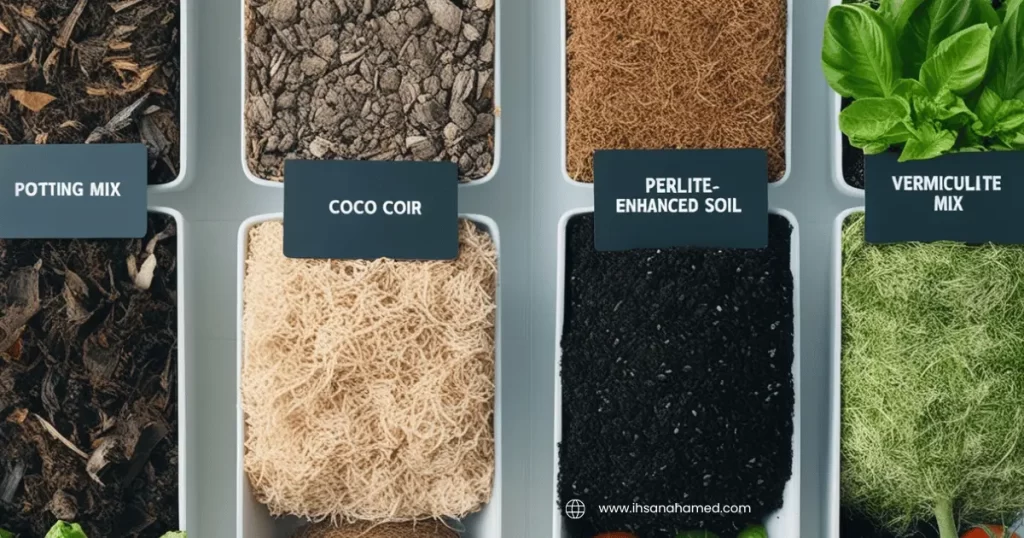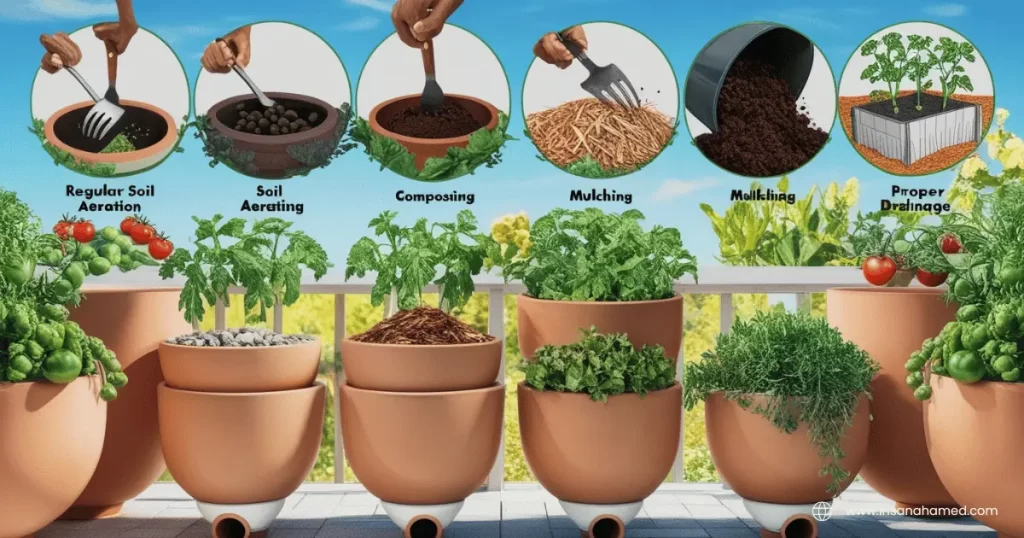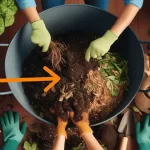1. Types of Soil for Indoor Container Vegetables

I want to share my experience with cultivating vegetables in pots inside my home. It’s a delightful hobby that I have enjoyed myself
Understanding the right Soil
Initially, I started container gardening with garden dirt but unfortunately, it’s harmed my plants. Finally, I realized potting soil is crucial For container gardening.
Here is why
- It allows their roots to breathe.
- It drains water properly.
- It supports robust plant growth.
Different Soils for various plants
I prefer choosing organic soil for better vegetables that add flavors and maintain a moisture level. Give proper attention to watering and that should not lead to overwatering. Use lightweight soils for smaller pants and hanging plants for easy handling, as the heavy mix can face problems with lifting.

Exciting alternatives: Growing Without Soil
You can successfully grow plants without traditional soil using alternatives like coco coir. My pepper plants flourished and remained pest-free.
I have a few straightforward steps to help you start
- Select your pot
- Choose the appropriate soil
- Fill the pot (but don’t pack it too tightly!)
- Plant your vegetable
- Water gently
- Watch it flourish

Learning from Experience
Learn from the Mistakes, learning experience is crucial for indoor gardening. It’s like a science experiment, testing soils. Abundant harvests, like cherry tomatoes, allow for sharing with friends.
Keep Trying and don’t give up
Don’t be discouraged by plant failures; it’s a normal part of gardening. Keep experimenting to enhance your skills with each attempt.
Growing vegetables indoors is enjoyable for me due to the learning experience and sense of accomplishment it provides. Understanding what helps plants thrive or struggle enhances my gardening skills.
Start your indoor garden with a pot and suitable soil and don’t worry about mistakes, every mistake makes you perfect and teaches you gardening. With persistence, you will enjoy fresh vegetables in your home.
Fun Facts About Indoor Gardening
- You can cultivate vegetables year-round.
- Indoor plants help purify the air.
- Some crops like lettuce grow incredibly quickly.
- Herbs can easily be grown as well
Remember these key points
- Use appropriate soil.
- Avoid overwatering.
- Ensure ample light reaches your plants.
- Enjoy yourself while learning throughout this journey
2. Essential Soil Properties for Thriving Indoor Vegetables

I have experimented and discovered soil mix ideas for indoor vegetables. Think of it as crafting the ultimate environment for your plants to flourish.
Soil pH: The Key ingredients
Every plant has specific soil pH preferences, it’s just like an ingredient in each dish. Most vegetables live in little acidic soil. An affordable pH tester helps monitor soil health. If soil is too acidic or alkaline, plants may find it difficult to digest nutrients.
Here is what I found
- My tomatoes turned yellow and droopy due to overly acidic soil.
- After adjusting the pH, they recovered and produced vibrant red tomatoes.
Drainage: No soggy roots
Plants are like humans, avoiding soggy conditions. Proper drainage prevents root rot and makes sure your pots have drainage holes in it. I also mix in perlite or small stones for better water flow. I learned this technique when my basil plant suffered from poor drainage and it helped me to produce better results after implementation.
Nutrient Content: Feeding your plants right
Plants need quality nutrition from the soil for healthy growth. I use a quality potting mix with blended fertilizers. Supplement with liquid fertilizer regularly to monitor a leaf color and pale leaf that requires more nutrients.

Moisture Retention: Finding Balance
Properly balanced moisture in the soil is essential for Plants and also Coconut coir maintains the moisture level, while perlite provides aeration. To check the moisture level use your fingers one inch down into the soil, if it is dry it’s time to water the plants.
Temperature: Keeping It away from the cold for windowsill vegetables
Most Plants live in warm conditions and it is similar to home temperature. During winter we must keep pots away from cold through windows, especially young plants, and consider using seedling heat mats.
From my personal experience, always keep pepper plants in warm areas in your home for rapid growth with proper plant care.
Here are some of my top tips for maintaining happy indoor veggie soil
- Regularly check and adjust pH levels.
- Ensure proper drainage.
- Feed your plants consistently.
- Maintain moisture without oversaturating.
- Find a warm spot for your pots.
Remember each plant has unique needs
- Experimentation is key to finding optimal care.
- Mistakes are part of the learning process in gardening.
- Proper soil care leads to thriving plants.
- Successful gardening can result in abundant, delicious produce, like cherry tomatoes.
3. Soil Management Techniques for Long-lasting Container Gardens

Over a period of time, focus on maintaining a better soil for your indoor vegetables. I have experimented with a few techniques that help my plant grow and be healthy.
Keeping Soil Fluffy
Sometimes plant roots require airy and loose soil and it can be achieved through perlite and vermiculite to push new roots. It’s essential for healthy growth to loosen the top layer with a fork and avoid compaction. Once, I neglected aeration, resulting in oddly shaped carrot plants that resembled squiggly worms.
Eliminating the harmful elements
Soil can contain harmful elements for plants. To eliminate harmful organisms, I just packed soil by spreading it on a baking sheet and oven it for 30 minutes and it can avoid producing an unpleasant smell. I prefer using this method when I find bugs in my soil.
Reusing the soil
I love recycling soil by mixing old potting mix with fresh material and compost. Remove dirty pieces before mixing and successfully reuse the same soil for crops to achieve better results.

Making Soil Even Better
Soils need an extra boost to reach their full potential. Here are some additional trips that work best:
- Verm compost (worm castings) which plants adore.
- Crushed eggshells provide essential calcium.
- A dash of coffee grounds adds nitrogen.
My tomato plants go wild with these additions—they grow so tall that it’s reminiscent of Jack climbing his beanstalk
- My Essential Soil Care Tips:
- Keep the soil aerated.
- Clean it if necessary.
- Recycle old soil.
- Add beneficial nutrients for your plants.
Caring for garden soil is essential and rewarding, similar to nurturing a pet. With proper care, plants thrive, leading to impressive results, like a massive zucchini.
Mistakes are part of the learning process, and setbacks offer valuable insights. Now, my indoor garden flourishes, providing fresh vegetables regularly.
4. Container-Specific Soil Considerations

Choosing the right soil for indoor container vegetables is crucial for plant health, and vertical gardening offers innovative techniques. I have tested various trips and techniques I will be exploring inside this guide.
How Deep Should Your Soil be
Soil serves as a nurturing environment for plants, akin to a cozy bedroom. Different plants have varying space preferences, with some thriving in larger areas while others adapt well to smaller spaces. This understanding can guide plant care and selection.
- Lettuce and herbs do not require a big container and they can work perfectly on shallow pots.
- Tomatoes and peppers require big containers and a lot of space is required for steady growth
- Root vegetables like carrots require deeper soil to grow long and straight.

Trust me, once I tried growing carrots in a shallow container, and it produced small orange golf balls.
Here’s a quick reference guide
- Shallow (6 inches) Lettuce, herbs, radishes
- Medium (8-10 inches) Bush beans, spinach, small peppers
- Deep (12 inches) Tomatoes, eggplants, large peppers
Vertical gardening Fun
Vertical gardening opts for a lighter soil mix that can handle easy-to-lift heavy containers. To maintain proper drainage add perlite and vermiculite to it. The soil needs to maintain a moisture level because it dries out faster in vertical gardening.
My Special Vertical Garden Mix
- 1 part potting soil
- 1 part coco coir (this spongy material helps retain water)
- 1 part perlite
- A dash of slow-release fertilizer
I crafted a striking wall of strawberries, resembling a green waterfall with red berries.
Tips for Vertical Garden Soil
- Keep it lightweight—avoid heavy clay soils.
- Ensure good drainage.
- Incorporate materials that retain moisture, such as coco coir.
- Use containers equipped with proper drainage holes.

Remember that vertical plants need extra attention
- Check their soil moisture frequently—they dry out faster
- Feed them regularly since they deplete nutrients quickly.
- If possible, rotate the plants so they all receive ample light.
I learned with care when my wall-mounted lettuce dropped often. Vertical gardening maximizes growth in limited spaces, transforming small areas into green homes.
Starting with simple wall planters that can help to fix most of the vegetables on a wall and it helps me to grow vegetables throughout the year with less effort.
5. DIY Soil Mixes: Crafting the Perfect Blend

Create and craft your soil mix with creativity and custom mixing for every unique plant that can satisfy the plant needs and its enjoyable rewards for your homes.
My personalized Potting Soil formulas
Nurturing plants requires personalized solutions and it can lead me to create custom potting soil blends. Each custom mix acts like a recipe for specific vegetables. For instance, my tomatoes need extra nutrients, so I mix compost with bone meal to provide a high nutrient and it can help in growth naturally.
My leafy greens thrive in a simple mix of potting soil, perlite, and slow-release fertilizer. Understanding each plant’s requirements and customizing for acidity, drainage, and nitrogen. I take detailed notes on my phone for future custom blends.
This personalized approach has helped me to stand out from others by bringing more fresh veggies with flavors during harvests.
Crafting Organic soil bends
For those avoiding chemicals, organic soil mixes are ideal but require effort to prepare. Start with high-quality compost for nutrients, then add peat moss or coco coir to improve water retention and aeration.

Special ingredients like crushed eggshells, rock dust, and kelp meal enrich your plant mix. You control the quality, ensuring your plants receive only organic and free from chemicals for optimal growth.
Lightweight soil Mixes
In limited spaces, lightweight soil mixes are essential. They work well in hanging baskets and small pots. Adding these components like perlite, vermiculite, and coconut coir helps keep the soil fluffy allowing roots to spread freely.
Using slow-release fertilizer in small amounts helps vegetables thrive in tight spaces. I once made a lightweight mix for trailing tomatoes that can grow easily on my DIY trellis and produced delicious fruits reminiscent of those from the farmer’s market.

Crafting your soil mixes is enjoyable as it allows for experimentation and discovery. It’s a fun way to find what works best for your plants. So, gather your containers and start blending custom soils to enhance your indoor garden
Conclusion
This comprehensive guide can help you with everything you need to know to create a perfect foundation for home production. Remember the quality of your soil is very important for high yield indoors.
Discover our few other guides on hydroponics and soil methods and how to face the major container problems with solutions.
Whether you choose a premium mix from the store or decide to craft your own custom soil for indoor container vegetables. Fill those pots with nutrient-rich customs soil and watch your indoor vegetables grow.
You might even become renowned in your neighborhood for the fresh veggies cultivated right in your apartment. Plus, by incorporating effective pest control strategies into your indoor container garden setup, you’ll ensure that both your vegetables and herb combos thrive beautifully together.
Most Frequently Asked Questions
1. What type of soil is best for indoor container vegetables?

A well-draining potting mix specifically designed for vegetables is ideal. Look for one that contains components like peat moss, perlite, and compost.
2. Can I use garden soil in my indoor containers?

It’s not recommended to use garden soil as it can compact, retain too much moisture, and introduce pests or diseases. Always choose a quality potting mix instead.
3. How often should I replace the soil in my containers?

It’s a good idea to refresh your potting mix every year or when you notice nutrient depletion or compaction, especially after growing heavy feeders.
4. Can I make my potting mix for indoor vegetables?

Absolutely! A simple homemade mix can include equal parts of peat moss, vermiculite (or perlite), and compost to ensure good drainage and nutrition.
5. Can I grow all types of vegetables in containers with the same soil mix?

While many vegetables can thrive in a standard potting mix, some may have specific needs; leafy greens do well in lighter mixes while root veggies might prefer denser soils tailored to their growth habits.







